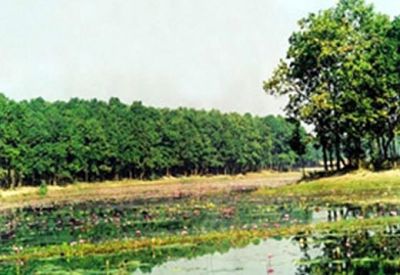Deciduous Forest
Deciduous Forest a forest where the major constituent trees shed their leaves during winter or dry season to reduce the loss of water through transpiration. In this type of forest the sal tree, Shorea robusta is the dominant species and comprise about 90 percent of the major floral composition. The tree attains a height of 10-25 m and most leaves drop off during winter. Generally the annual rainfall to these forest areas is about 2000 mm.

Because of the predominance of sal trees, the tropical moist deciduous forest of Bangladesh are commonly known as 'Sal Forests'. These forests are now distributed in Dhaka, Mymensingh, Nawabganj, Rangpur, Dinajpur and Comilla regions.
They constitute two distinct belts (covering about 107,000 ha of land); the larger one falls between the Bhramaputra and the Jamuna rivers with a length of about 80 km and a width of 7-20 km. This part is known as Madhupur Garh. The other smaller belt is situated at Sherpur district and lies along the foothills of the Garo hills of India, having a length of about 60 km and width of 1.5-10 km.
There are some smaller remnant patches of forest areas in Rangpur, Dinajpur, Thakurgaon, and Naogaon districts (covering about 14,000 ha) with some remainings in Shalvan Vihara, Mainamati and Rajeshpur in Comilla (about 200 ha).
Until late 19th century, these forests existed as a continuous belt from Comilla to Darjeeling of India. At present, most of the forest areas are under occupation and the present remaining stands of sal are of poor stocking and quality, consisting of degraded coppice and plantations. The present notified area of this forest is largely honeycombed with rice fields and other cultivated land. The forest forms more or less a uniform canopy of 10-20 m, mostly with deciduous plants. Besides sal (about 90%), the other common trees are palash (Butea monosperma), haldu (Adina cordfolia), jarul or shidah (Lagerstroemia parviflora), bazna, hargoja or ajuli (Dillenia pentagyna), bhela, koroi, menda (Litsea monopetala), kushum, udhal, dephajam, bahera, kurchi, haritaki, pitraj, sheora, sonalu, assar, amlaki and adagash (Croton oblongifolius). Climbers (mostly woody) like kanchan lata, anigota, kumari lata, gajpipal, pani lata, Dioscorea species, satamuli, and gila occur in these forests. A good number of undergrowth is also recorded (about 250 species under 50 genera). The common ones are assam lata, bhat, boichi, moina kanta and ashal. The significant grass is sungrass. Few epiphytes are also recorded. Legumes, euphrobias and convolvulous plants also occur. The deciduous forests of Bangladesh show clear signs of degradation due to human interference and illegal cuttings of the forest trees. [SM Humayun Kabir]
See also forest and forestry.
